There is no shortage of temples in Chiang Mai; there are over 200 of them dotted across the city, so picking the best ones could be challenging. There are several types of temples in Chiang Mai. Some are easy to locate, some are near your accommodation, some are hidden away along alleyways, and some need hiking. You won’t be let down no matter whatever “wat” you decide to visit! They’re all stunning, fascinating, and full of history. The architecture of the Buddhist temples in this area of Thailand is largely influenced by Thai-Lanna style architecture as well as styles from neighbouring countries like Burma. There is a wealth of historical information and artefacts to be learned from Chiang Mai’s temples. When visiting these historic holy locations, it’s crucial to remember to dress appropriately. Remember to wear shoes and dress appropriately, including long trousers and a shirt that protects your shoulders! As visitors to their stunning nation, we have no right to disregard their sacred sites. Our selection of the top ten temples in Chiang Mai is provided here, and it is not ranked in any particular order. Regardless of the temple you select, you will undoubtedly take in breathtaking vistas, an abundance of historical information, and Buddhist principles and teachings.
1. Wat Phra That Doi Suthep
By far the most frequented and well-known temple in Chiang Mai is Wat Phra That Doi Suthep, one of the holiest temples in all of Thailand. High above Chiang Mai, the temple is perched on a mountaintop beside Doi Suthep mountain. Half the wonder of Wat Doi Suthep is in getting there; the drive takes roughly thirty minutes from the city centre. This temple is surrounded on all sides by breathtaking views of the surrounding landscape and is situated right in the centre of Doi Suthep National Park. A magnificent example of Thai architecture, Wat Phra That Doi Suthep features elaborate statues, multi-tiered temples with colourful roofs, and a gold Chedi that rises to a height of almost 80 feet. The wat is accessible via a 300

In addition to drawing thousands of visitors, this temple is a well-liked destination for Buddhist devotees on pilgrimages. One of Thailand’s most renowned temples, Wat Phra That Doi Suthep, is well worth a visit, if only to snap some pictures of the breathtaking mountaintop panorama.
2. Wat Phra Singh
Wat Phra Singh, popularly referred to as the “Golden Temple,” is the second most visited temple in Chiang Mai. Conveniently situated on the west side of Ratchadamnoen Road inside the old city wall is this temple. Another outstanding example of Thai Lanna-style architecture is the temple. The colours ochre, white, and gold are skillfully used to embellish the grounds. Shining golden chedis, beautiful roofs, and well-kept gardens are all contained within the white walls of the property.
Among the many architectural highlights of Wat Pha Singh are its main chedi, Viharn Luang, and Viharn Lai Kham, a sizable gathering hall. The vibrant paintings depicting local life in the fourteenth century and the beautifully decorated viharns (assembly hall) of this temple draw large crowds of tourists.
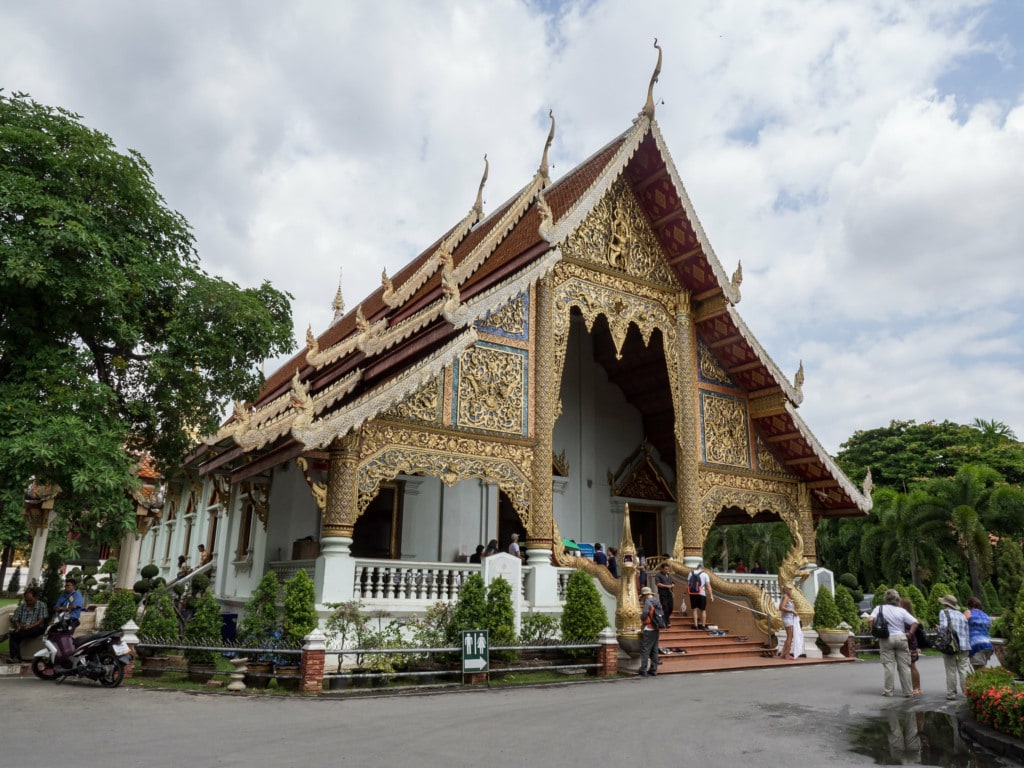
King Phayu constructed Wat Phra Singh in 1345 to house his father’s remains. The temple was abandoned after the Burmese acquired control of northern Thailand between 1578 and 1774. until Chiang Mai was ruled by King Kawila in 1782, who rebuilt the temple
3. Wat Chedi Luang
Halfway along Ratchadamnoen Road, in Chiang Mai’s old city centre, is where you’ll find Wat Chedi Luang. Wat Chedi Luang, sometimes referred to as “the Temple of the Great Stupa,” is a prominent landmark in Chiang Mai’s skyline because of its massive, abandoned chedi or pagoda. The temple is home to several buildings with significant cultural value, including the major viharn, the city pillar, which to the Lanna Kingdom represents both the city’s and the universe’s centre, and of course the temple’s massive stupa, or chedi. Three separate temples that once shared the land now cohabit as one.

This temple took more than a century to construct and was constructed sometime between 1391 and 1402. The chedi reached a height of 262 feet and a width of about 200 feet at its peak. The Emerald Buddha, Thailand’s most revered relic, was formerly housed in the chedi. This temple offers stunning views and architecture in addition to insightful historical information. Talking one-on-one with the monks, who are mainly beginners, is a special experience that Wat Chedi Luang offers. You can ask the monks questions about Buddhism, the temple, or Thailand in general during these hosted talks. The chedi was lowered to slightly more than half of its original height in 1545 during an earthquake. The naga staircase and the elephant figurines that adorned the base were completed in 1992. Nevertheless, the chedi itself remains as it was and was never brought back to its former splendour.
4. Wat Chiang Man
Situated at the intersection of Ratchaphakinai Road and Phra Poklao Road, within the old city centre, is another temple called Wat Chiang Man. The temple features stunning examples of historic architecture, with varying designs as a result of years of additions. Wat Chiang Man is home to two viharns, a scripture library, an ordination hall called ubosot, and a gold-plated chedi. Some of the oldest Buddhist resources and artefacts in Thailand can be found here.
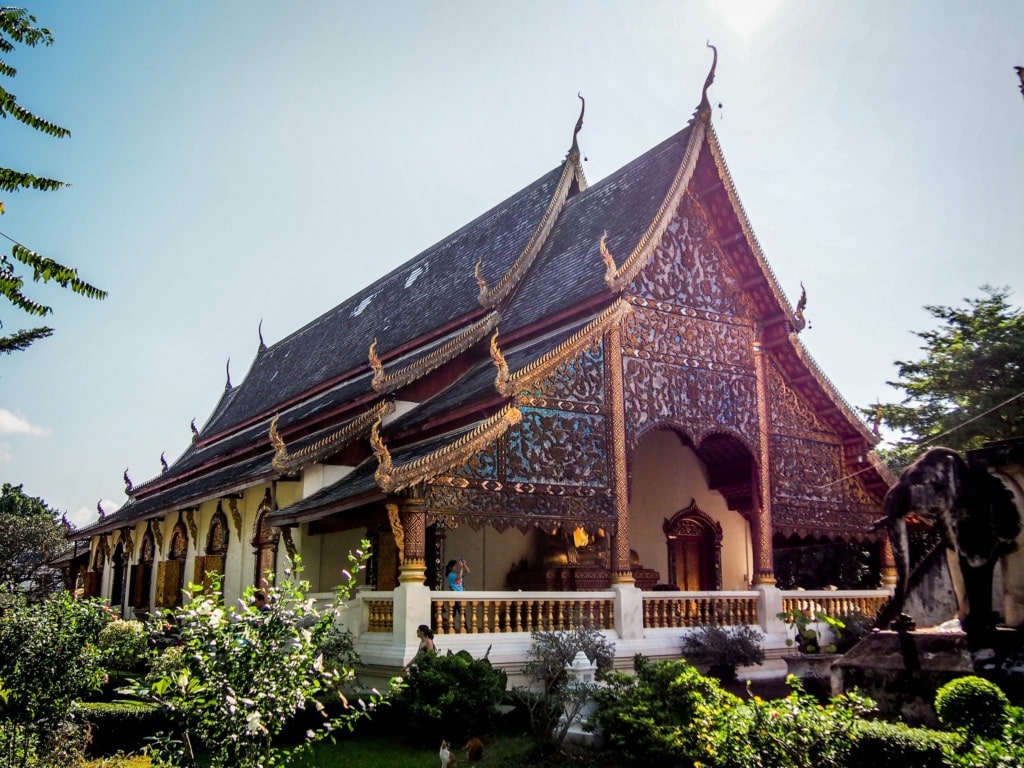
The oldest temple in Chiang Mai is Wat Chiang Man, which King Mengrai constructed in 1296. The king constructed this temple as the first of the new city when he made the decision to build a new city to serve as the Lanna Kingdom’s capital. There are some very old Buddha images in this temple. There are several historical and cultural artefacts on the grounds of this shrine. Some of the most ancient artefacts of any temple in Chiang Mai may be found in this temple, including a significant crystal Buddha statue and numerous Buddhist writings. There are lovely garden sanctuaries to sit in after exploring the temple and contemplate your stay. One of Chiang Mai’s best-kept secrets is Wat Chiang Man, despite being right in the middle of the city. The temple is a great spot for introspection and is rarely crowded. If you want to explore one of the oldest Buddhist temples and find out more about Thailand’s history, go to Wat Chiang Man.
5. Wat Suan Dok
Wat Suan Dok is situated one km west of the Suan Dok gate on Suthep Road, outside the city limits. Among Chiang Mai’s most photogenic temples is this one. The site is dotted with numerous white pagodas and features a 160-foot-tall, gold-covered chedi in the centre. The other recently refurbished structures, which include a sizable sermon hall and ubosot, are located beyond the pagodas. The main pagoda, plated in gold, houses a variety of Buddha relics, while the white pagodas serve as a tomb, containing the ashes of numerous former royal characters. This temple is filled with exquisite allusions to the Buddha in the form of statues and paintings.
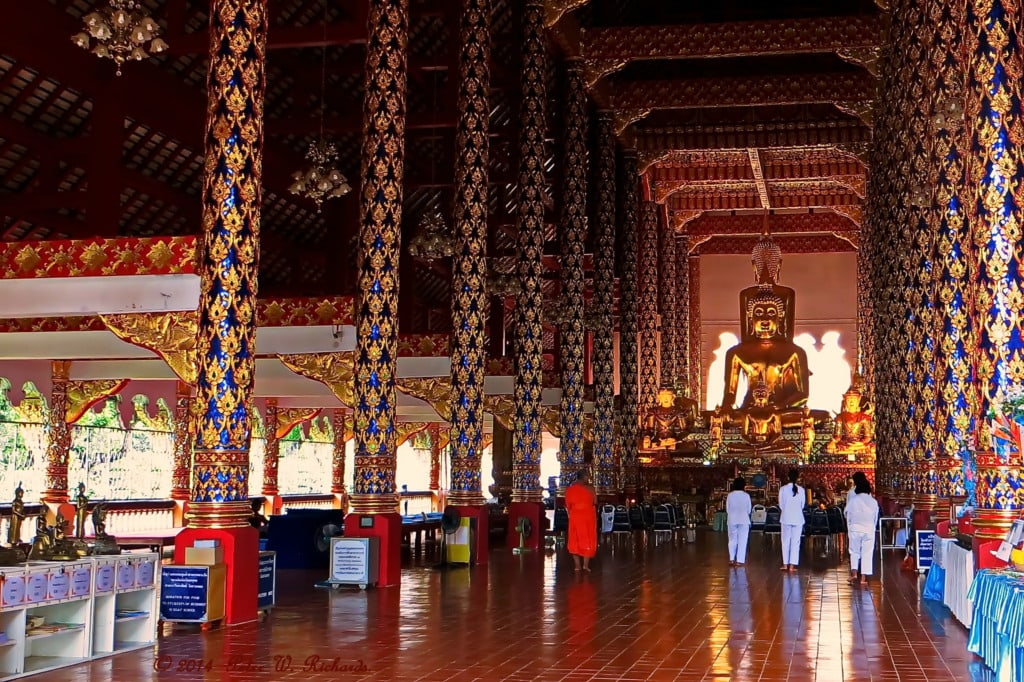
You’ll probably discover that Wat Suan Dok is more engaging than a lot of the other temples in Chiang Mai. You can ask any pertinent inquiries in the English-hosted chat rooms that the monks provide. If you want to immerse yourself in Buddhism, the temple also provides vipassana and guided meditation sessions. Wat Suan Dok, the temple, is a renowned destination in Chiang Mai because it houses half of an extremely old Buddhist artefact. This temple is significantly less crowded and holds half of the artefacts that Wat Phra Doi Suthep keeps. One of the greatest locations for sunset photography is Wat Suan Dok, where the grandeur of this temple is emphasised by the sun’s reflection off the white and gold structures.
6. Wat Umong
The only forest temple in Chiang Mai is Wat Umong. The temple spans 15 acres of forested land and is situated at the base of Doi Pui Mountain. With its unpainted stupa, meditation caves, and ancient, intact ruins, this temple is among the most fascinating. Wat Umong, despite being one of the less ostentatious temples, provides a view into an old temple with an active monastery. An old temple known as Wat Umong was constructed in 1297, a year after Chiang Mai was designated as the new capital. This temple was constructed by King Manglai for a Chiang Mai monk who practiced tunnel meditation. The monk found it difficult to meditate as the city grew and became congested, so the King constructed Wat Umong.

Monks might be seen strolling the grounds or circumnavigating the enormous stupa within the temple complex. The temple attracts so many tourists that the tunnel system is no longer used for meditation, but you can still explore it. In addition, there is a sizable lake and a little island in the middle of the lovely property that can be accessed by bridge. This temple is a rare find in Chiang Mai because it is the only one in the jungle and provides guests with Dhamma discourses and meditation. Every Sunday from 3-6 pm are the talks.
7. Wat Phra That Doi Kham
Known by many local Thais as the Golden shrine, this shrine enjoys great popularity among them. Situated on a hill, the temple is 15 miles southwest of the city centre. The 55-foot gold-decorated Buddha statue at this temple is the primary attraction. It can be viewed from both the main road and the foot of the hill. The temple is known as the Golden Temple because of its gold-covered statues, decorations, and roofs.
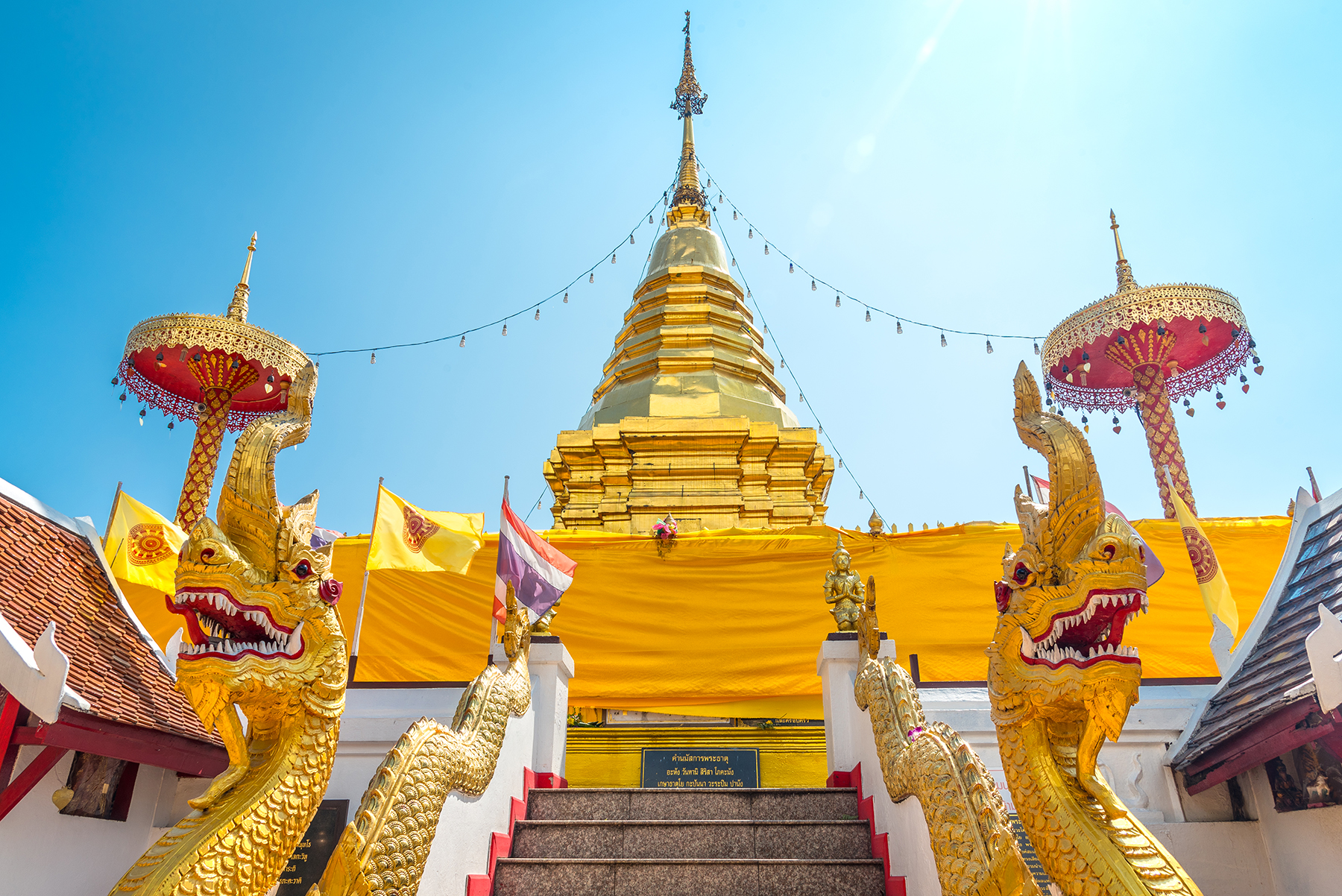
During the reign of Queen Jammathewee in 1230, this temple was constructed. Though the villagers refer to it as Doi Kham, the temple was formerly known as Suwannabanpot Temple. When the rain pulled down the chedi, the temple was abandoned; but, in time, finances were obtained and renovations were made. Numerous exquisite and historic Buddhist artefacts, including paintings dating back to the thirteenth century, may be found at Wat Phra That Doi Kham. In addition, Wat Phra That Doi Kham provides breathtaking views of the surrounding mountains and cities. Viewing Wat Phra That Doi Kham will allow you to get a glimpse of a well-liked local temple that is seldom frequented by tourists.
8. Wat Sri Suphan
Chiang Mai’s city centre is home to Wat Sri Suphan, which is clearly identifiable from the street because of its all-silver exterior.
Wat Sri Suphan’s entire exterior is covered in silver, earning it the nickname “Silver Temple.” Silver elaborate decoration covers the walls, the roof, and even the statues and decorations. The interior is adorned with silver accents as well, featuring mirror displays and vibrant colour schemes. Silver Buddha statues adorn the temple’s altars and guard the entrance. Unfortunately, because of outdated Buddhist regulations, this temple is still off-limits to women. Still, the stroll through the city centre is worthwhile just to get a glimpse of the entire silver exterior. King Mengrai first established Wat Sri Suphan in 1501, but it took more than a century to complete the original structure. The temple has undergone numerous renovations and redesigns since then. Built in the 1500s for the Chiang Mai community of silversmiths, Wat Sri Suphan still sustains the trade in the region today.

This temple is unlike any other in Chiang Mai since nearly the whole structure is covered in “silver.” (in reality a zinc covering and alloy; holy artefacts were spared the silver coating). Even from the outside, the sight of this temple is breathtaking. Because of its handy proximity, a quick stopover rather than a full day excursion is all that is required to visit this temple.
9. Wat Inthakin
In the centre of the Old City, Wat Inthakin is a distinctive temple situated on the side of the road. Only a few metres separate the cars on Inthawarorot Road from the temple’s perimeter. One of those temples you could just happen upon when out and about in the city.

Notwithstanding its peculiar position, Wat Inthakin is a magnificent temple. Simply because of its stunning black viharn walls and magnificent gold decals all over the grounds, this temple is one of my favourites. This little temple has a viharn, two chedis, and living quarters for monks. It is unclear exactly when the temple was constructed, but it was done so in the late 13th century. At the site of the former historic city centre, King Mengrai erected a pillar in the gardens of the temple in 1292. For that reason, this temple is also known as “the City Navel Temple.” The pillar was relocated to Wat Chedi Luang in the 1800s, and it is still there. Situated in the middle of the bustling old city, the temple is modest, peaceful, and unique. Situated within the ancient city, the temple makes a convenient stopover between other sites.
10. Wat Chet Yot
The Nimmanheim neighbourhood is home to this temple, which is three minutes’ drive from the Maya Shopping Mall.
Numerous antique architectural landmarks, including the temple entrance gate, an antiquated viharn, and several chedis containing antiquated treasures and artefacts, can be found at Wat Chet Yot. With its old red brick façade rather than its gleamingly painted roofs, Wat Chet Yot’s exterior is a unique find in Chiang Mai. One of the rare instances of Hindu-Lanna architecture is this temple. Built by King Tilokkarat in 1455, Wat Chet Yot. The Mahabodhi Temple in Bagan, Burma is a replica of the Mahabodhi Temple in Bodh Gaya, Northern India.
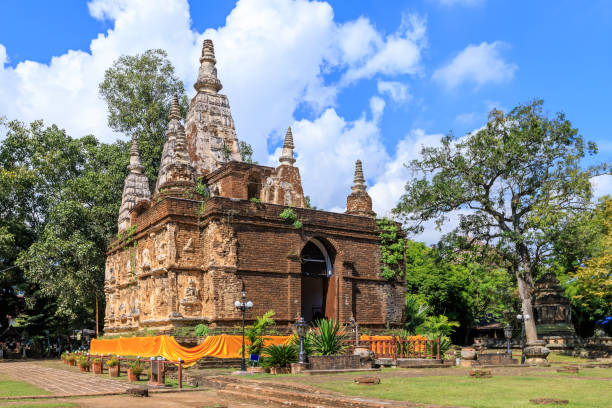
The King sent monks there to study the temple’s architecture. To stop the Buddhist faith from dwindling, the King ordered that the temple be constructed in the image of the Mahabodhi Temple. Local Thai people who were born in the year of the snake are said to make pilgrimages to this temple. It’s also said that you might support the success and tranquilly of your thoughts by showing respect here. Those who appreciate ruins and historic architecture will find this temple to be interesting. This temple has been standing for a very long time, therefore it is dilapidated and rough, with bricks breaking apart. With lots of lovely area for introspection and meditation, Wat Chet Yot provides a tranquil haven.
FAQ’S:
Q1.Why should I visit Chiang Mai Temples?
Chiang Mai is renowned for its rich cultural heritage, and its temples showcase exquisite architecture, intricate details, and religious significance. Visiting these temples provides a unique and spiritual experience.
Q2.Which temple is the most famous in Chiang Mai?
Wat Phra Singh is often considered the most famous temple in Chiang Mai due to its stunning Lanna architecture and the revered Phra Singh Buddha image